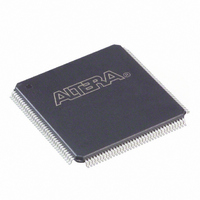EP2C5T144I8N Altera, EP2C5T144I8N Datasheet - Page 63

EP2C5T144I8N
Manufacturer Part Number
EP2C5T144I8N
Description
IC CYCLONE II FPGA 5K 144-TQFP
Manufacturer
Altera
Series
Cyclone® IIr
Datasheet
1.EP2C5T144C8N.pdf
(168 pages)
Specifications of EP2C5T144I8N
Number Of Logic Elements/cells
4608
Number Of Labs/clbs
288
Total Ram Bits
119808
Number Of I /o
89
Voltage - Supply
1.15 V ~ 1.25 V
Mounting Type
Surface Mount
Operating Temperature
-40°C ~ 100°C
Package / Case
144-TQFP, 144-VQFP
Family Name
Cyclone® II
Number Of Logic Blocks/elements
4608
# I/os (max)
89
Frequency (max)
402.58MHz
Process Technology
90nm
Operating Supply Voltage (typ)
1.2V
Logic Cells
4608
Ram Bits
119808
Operating Supply Voltage (min)
1.15V
Operating Supply Voltage (max)
1.25V
Operating Temp Range
-40C to 100C
Operating Temperature Classification
Industrial
Mounting
Surface Mount
Pin Count
144
Package Type
TQFP
Lead Free Status / RoHS Status
Lead free / RoHS Compliant
Number Of Gates
-
Lead Free Status / Rohs Status
Compliant
Other names
544-2139
Available stocks
Company
Part Number
Manufacturer
Quantity
Price
Company:
Part Number:
EP2C5T144I8N
Manufacturer:
ALTERA41
Quantity:
710
Part Number:
EP2C5T144I8N
Manufacturer:
ALTERA/阿尔特拉
Quantity:
20 000
Altera Corporation
February 2007
Slew Rate Control
Slew rate control is performed by using programmable output drive
strength.
Bus Hold
Each Cyclone II device user I/O pin provides an optional bus-hold
feature. The bus-hold circuitry can hold the signal on an I/O pin at its
last-driven state. Since the bus-hold feature holds the last-driven state of
the pin until the next input signal is present, an external pull-up or
pull-down resistor is not necessary to hold a signal level when the bus is
tri-stated.
The bus-hold circuitry also pulls undriven pins away from the input
threshold voltage where noise can cause unintended high-frequency
switching. You can select this feature individually for each I/O pin. The
bus-hold output drives no higher than V
signals.
1
The bus-hold circuitry is only active after configuration. When going into
user mode, the bus-hold circuit captures the value on the pin present at
the end of configuration.
The bus-hold circuitry uses a resistor with a nominal resistance (R
approximately 7 kΩ to pull the signal level to the last-driven state. Refer
to the DC Characteristics & Timing Specifications chapter in Volume 1 of the
Cyclone II Device Handbook for the specific sustaining current for each
V
used to identify the next driven input level.
Programmable Pull-Up Resistor
Each Cyclone II device I/O pin provides an optional programmable
pull-up resistor during user mode. If you enable this feature for an I/O
pin, the pull-up resistor (typically 25 kΩ) holds the output to the V
level of the output pin’s bank.
1
CCIO
voltage level driven through the resistor and overdrive current
If the bus-hold feature is enabled, the device cannot use the
programmable pull-up option. Disable the bus-hold feature
when the I/O pin is configured for differential signals. Bus hold
circuitry is not available on the dedicated clock pins.
If the programmable pull-up is enabled, the device cannot use
the bus-hold feature. The programmable pull-up resistors are
not supported on the dedicated configuration, JTAG, and
dedicated clock pins.
Cyclone II Device Handbook, Volume 1
CCIO
to prevent overdriving
Cyclone II Architecture
BH
CCIO
2–51
) of















